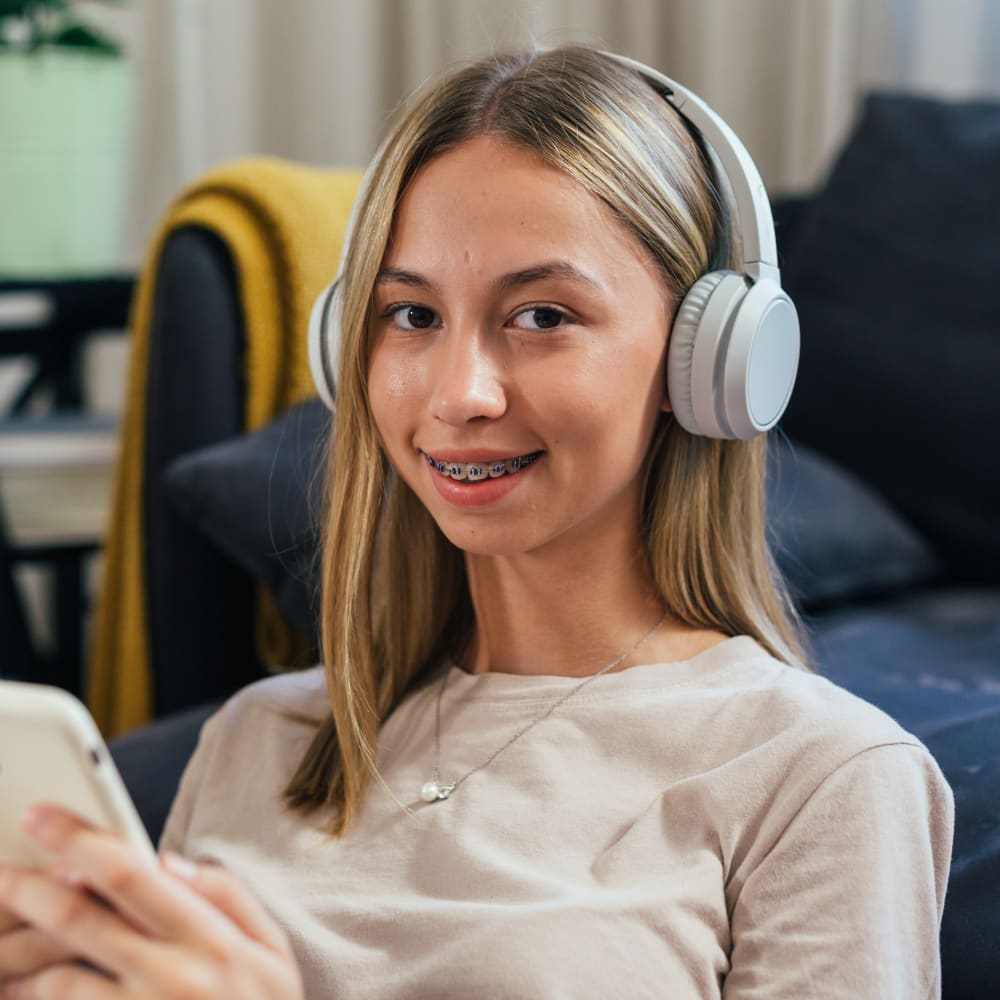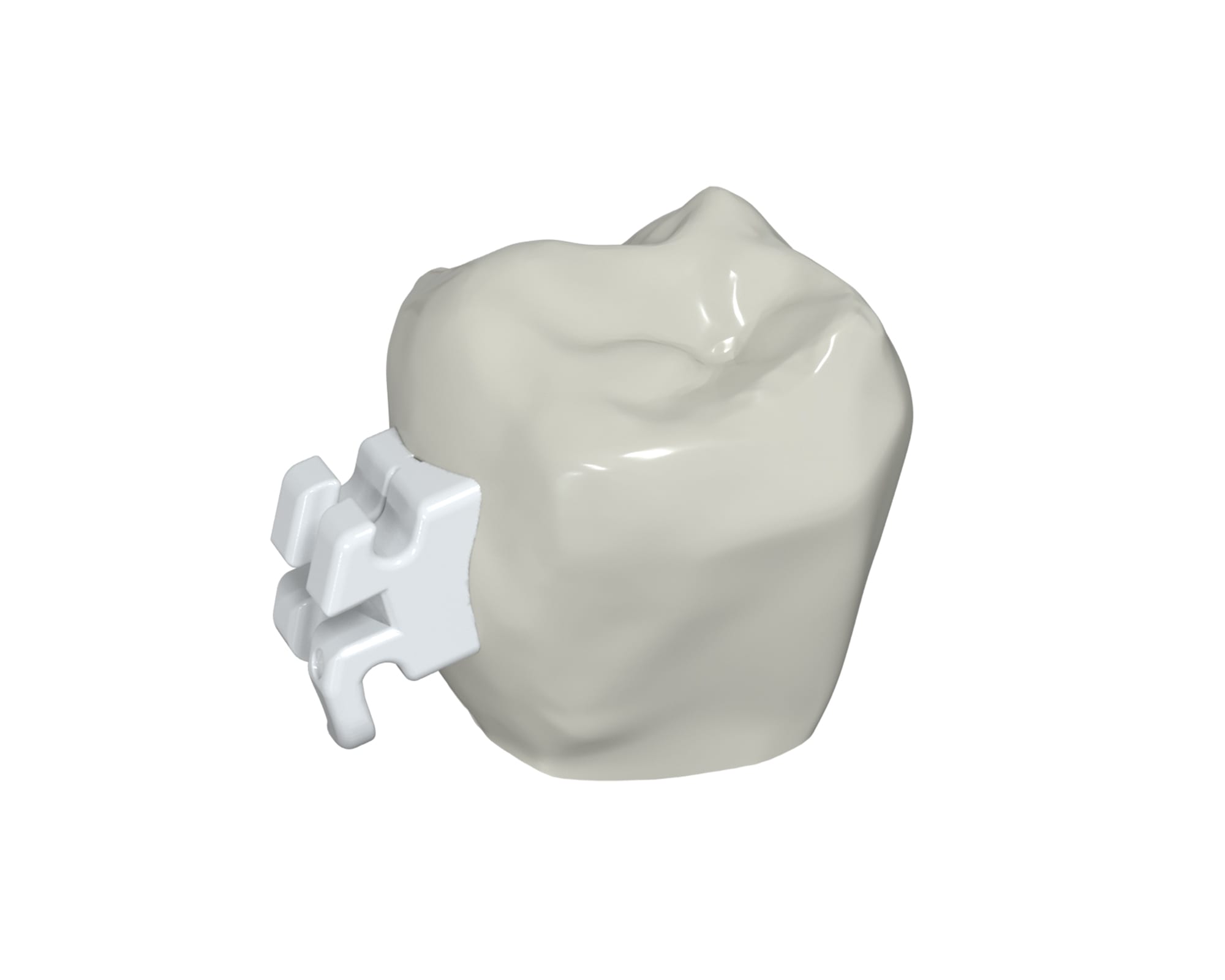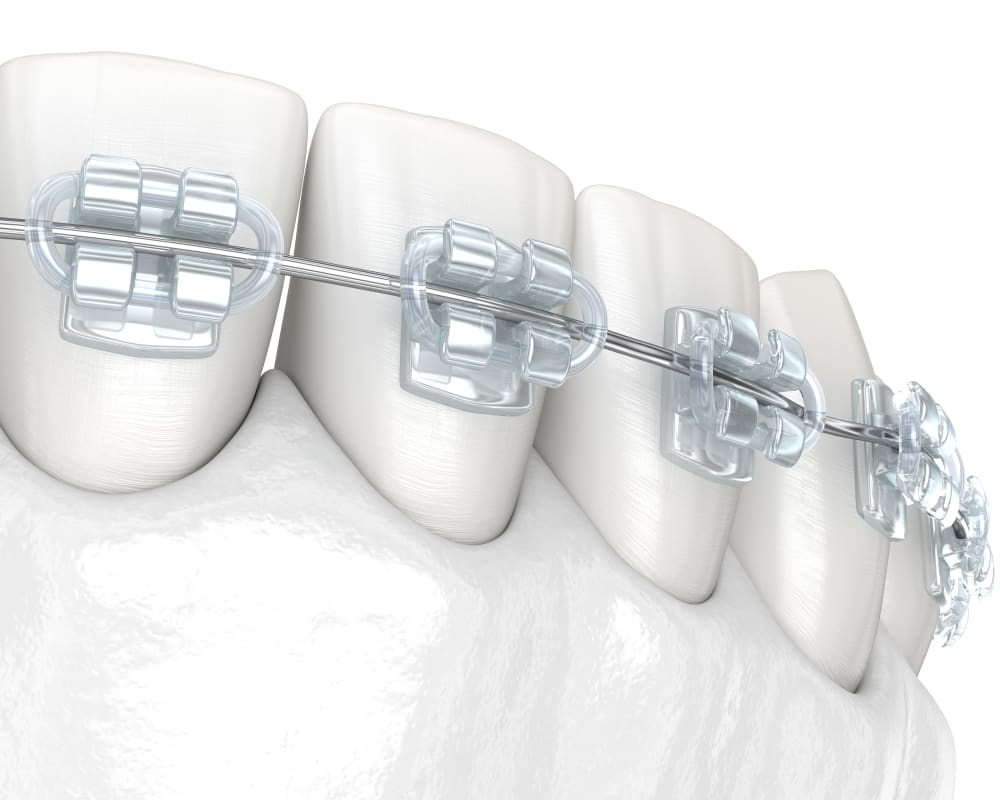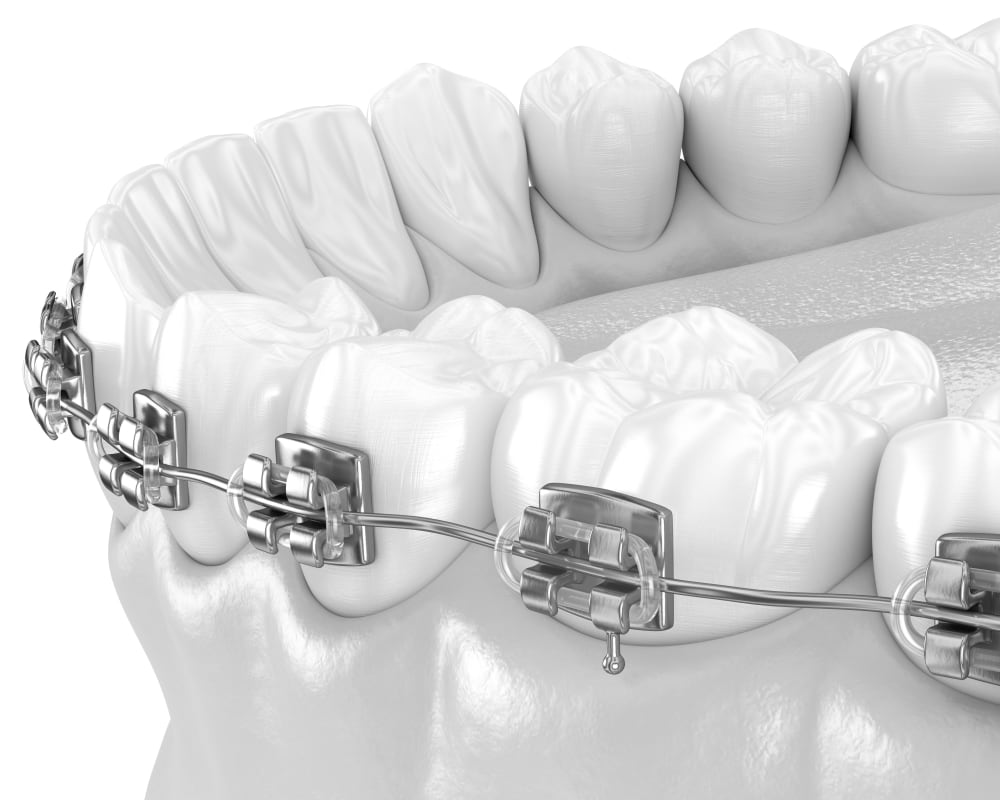An Effective Way to Create Healthier, Happier Smiles
Conventional braces are a time-tested method for straightening teeth – orthodontists have been using them successfully for decades to align smiles and improve bites.
There are three basic elements to orthodontic braces: individual brackets, a flexible archwire that runs across the brackets, and in some cases, elastic bands.
The brackets are fixed to the fronts of the teeth and hold the archwire in place. The arch wire places pressure on the teeth, moving them into the desired positions. Elastic bands are used to apply more force in specific directions.
Braces are a highly versatile orthodontic treatment option. They can be used to correct almost any type of orthodontic issue, from moderate to complex, for children, teens and adults of all ages.
Today's braces also come in a number of style options that provide a cleaner, lower-profile appearance for people who are concerned about aesthetics.

Flexible Payment Plans
Your smile is yours forever, and we want to make it as easy as possible for you to receive the best orthodontic care whenever you need it. At Paleczny Orthodontics, we will work with you to create a payment plan that fits your budget.
Types of Braces at Paleczny Orthodontics
The type of braces we recommend for you will depend on a number of factors, including your specific orthodontic condition and your budget. We offer the following options:

LightForce 3D Printed Braces
LightForce braces are one of the latest innovations in orthodontic treatment. With LightForce, brackets are 3D-printed to precisely fit the unique contours of each individual tooth, giving your orthodontist total control over how individual teeth are repositioned.
Made from polycrystalline alumina, these brackets blend in with the natural colour of your teeth, providing you with a more discreet appearance.
The LightForce digital software allows your orthodontist to design a customized treatment to meet your specific needs. Based on your prescription, LightForce designs and 3D prints your braces, ready to be fitted in place at your orthodontist's office.
LightForce brackets are 100% personalized to fit your unique teeth, and provide effective orthodontic treatment with a more subtle appearance.
Translucent Braces
'Translucent' is a bit of a misnomer in that these braces are not actually see-through – they blend in.
The brackets are made from a ceramic tooth-coloured material designed to blend in with your teeth, creating a transparent effect and making them less obvious than standard metal braces.
While translucent braces are a great option for many, they're not ideal for everyone. Ceramic is not as strong as metal, so there are some orthodontic conditions that are better resolved with traditional metal braces.


Traditional Metal Braces
This style of orthodontic braces has been in use the longest and is known for its efficacy, durability, and affordability.
With traditional metal braces, metal brackets are affixed to the teeth, with arch wires threaded through them to guide teeth into their prescribed positions. Elastic ties or metal wires hold the archwire in place.
The wires are usually made of metal alloys, and have been designed to provide sufficient force to straighten the teeth and also be as comfortable as possible for the patient.
Adjusting to Life with Braces
Braces take a bit of getting used to at first, but you'll develop new routines around them in no time. Here are a few things that will affect your day-to-day life while straightening your smile with braces.
Adjustments
Adjustments are a crucial component of orthodontic treatment with braces. Every four to eight weeks or so, you'll visit our office to have your braces adjusted. Adjustments keep teeth moving according to your treatment plan.
It's completely normal to feel some discomfort in the hours or days after your adjustment appointments as your mouth adjusts. This discomfort is temporary, and best managed with over-the-counter painkillers.
Elastics
Elastics, also called rubber bands, are used with traditional braces to apply additional force to certain areas of your mouth to guide tooth movement. They are a key part of your treatment.
Elastics do not maintain their strength for long, though, and need to be changed out at least twice a day. Many of our patients find that making it a habit to change their elastics after each meal makes it easier to remember.
Always follow your orthodontist's instructions regarding your elastics. Contact our office if you find that your elastics break frequently, or if the hook for your elastics breaks off.
Hygiene
Good oral hygiene is more important than ever when you have braces. Braces create all sorts of small spaces and crevices where plaque can build up, leading to tooth discolouration, tooth decay, and gum disease.
To keep your teeth and gums healthy during your braces treatment, be sure to brush after each meal using a soft toothbrush and fluoride toothpaste. A Proxabrush is a specially shaped toothbrush designed to clean out the spaces between braces. You can also use a Waterpik or air flosser to help flush out stubborn food particles.
You should also floss frequently. This is easier than you might expect. You can just feed the floss down through the space between the archwire and your teeth. Pull the end gently towards the back of the tooth and draw the floss up and down between the teeth.
Eating
Undergoing orthodontic treatment with braces, unfortunately, requires some limitations to your diet.
Foods that you'll need to avoid include chewy or sticky foods (like caramel or licorice), hard or crunchy foods (hard candies, nuts, or whole raw vegetables), and foods you have to bite into (like corn on the cob or apples). You'll also need to avoid sugary drinks.
Cutting food into small pieces and chewing slowly and carefully will allow you to enjoy more variety during your treatment, but always defer to your orthodontist's recommendations.
Mouth Guards
Don't let braces stop you from playing the sports you love. To help reduce the risk of injury when you are out on the field, court, or rink during your treatment, we recommend wearing a sports mouth guard to protect your teeth, your mouth, and the braces themselves from damage.
Retainers
After your active orthodontic treatment with braces (or Invisalign) is complete, you'll need to wear a retainer to keep your teeth in their new, straightened positions while the jaw bone around their roots reforms and hardens.
You'll probably start out wearing your retainer for at least 12 hours a day, every day, during the first eight weeks or so after braces. From there, with approval from your orthodontist, you may begin wearing it at night only.
Questions About Braces? We've Got Answers.
If you're considering orthodontic treatment with braces, you likely have some questions. Get started by reading the answers to our braces FAQs to learn more about how they work, and their benefits.
-
How much do orthodontic braces cost?
The cost of treatment with orthodontic braces varies considerably from one person to another.
The cost of your braces treatment will depend on the nature and severity of your misalignment. It can also vary depending on the type of braces used. Translucent braces, for example, tend to be more expensive than traditional metal ones.
-
Who is a candidate for braces?
Children, teens and adults can all be considered good candidates for braces depending on the needs of their smile and the overall condition of their oral health. That said, certain people with significant recession or oral health conditions may not be candidates.
Braces come in a variety of styles and can address a wide range of moderate to complex orthodontic issues, so there are very few limits to who can benefit from braces.
-
What are my options for low-profile braces?
We offer translucent (polycrystalline) braces at Paleczny Orthodontics.
Translucent braces have brackets that are made from white polycrystalline that blends in with your smile. You can learn more about both these types of braces on this page under 'Types of Braces'.
Invisalign clear aligners are also an option for low-profile orthodontic treatment.
-
How long will I need to wear braces?
The average treatment time for braces is 12 to 24 months, but this can vary significantly from patient to patient. The duration of your orthodontic treatment depends primarily on the type and severity of your misalignment. As you might expect, mild or moderate cases are quicker to treat than more complex ones.
-
How long until I get used to my braces?
You'll probably need a week or two to become fully accustomed to your braces after your first get them. You may find it hard to resist poking them with your tongue as you get used to how the wires and brackets feel.
You may also notice that certain areas of your mouth rub against the braces and get sore. Orthodontic wax can be placed on the braces in these areas to help create a smoother surface with less friction as your mouth adjusts. Again, this discomfort is temporary, and after a couple of weeks, your mouth will likely feel normal again.
-
Can I change the colour of my braces?
If you have metal braces with rubber bands, you can update the colour of your braces when you come in for an adjustment appointment. Orthodontic elastics can come in a rainbow of different colours for you to choose from. Having the option to personalize your braces in this way can make the orthodontic treatment process a little more fun!
We also often use e-chain to close the spaces between teeth, and these come in lots of colours as well.
You can change your braces colour based on the season, upcoming holidays, or your personal style.
-
Do braces hurt?
You will almost certainly experience some discomfort at different points of your orthodontic treatment with braces. However, any pain you feel during your braces treatment is temporary and usually resolves over a few days or even hours.
Discomfort from braces usually happens for a week or so after you first get them, and also for a few hours or days after your adjustment appointments, as the teeth begin to shift. Patients tend to describe it as a sensation of pressure or an ache. This type of pain is usually easily managed with over-the-counter painkillers like ibuprofen until it has passed.
Another type of temporary discomfort you may experience during your braces treatment is when the brackets rub against the inside of your mouth. This can also happen when you first get your braces and directly after adjustment appointments. Orthodontic wax can be applied to the braces in the areas where the rubbing occurs to create a smoother surface against the inside of your mouth. You can also use painkillers to manage this discomfort until it passes.
-
Can adults get braces?
Absolutely! Many adults are excellent candidates for braces! More and more adults these days are opting to undergo orthodontic treatment that they missed out on when they were younger, to improve their oral health and the appearance of smiles.
Often, our adult patients prefer the lower profile, more streamlined look of translucent ceramic braces or Invisalign. All these options allow you to straighten your teeth without the more pronounced appearance of traditional braces.
-
Can kids get braces?
Yes, children as young as seven years old may be candidates for braces, although at Paleczny Orthodontics, we typically prefer to wait until all the adult teeth have come in before beginning braces treatment.
Braces can be a durable and efficient treatment option for many children.
-
Do I have to brush more with braces?
Yes, it's a good idea to brush your teeth at least after each meal throughout your braces treatment.
Oral hygiene becomes more important than ever while you're wearing braces. The presence of braces in your mouth introduces a multitude of tiny crevices, nooks, and crannies that were not there before. It's very easy for food particles to get caught in these tiny spaces, making them a breeding ground to bacteria.
To avoid developing cavities (not to mention tooth discolouration and bad breath) extra vigilance with your oral hygiene is essential.
-
How do I floss with braces?
Flossing with braces may seem complicated, but it's fairly straightforward once you get the hang of it!
To floss your teeth with braces, feed the floss down through the space between the arch wire and your teeth. We supply floss threaders for our patients to make this easier. Pull the end of the floss gently towards the back of the tooth and draw the floss up and down between the teeth. Then repeat this process between each pair of teeth.
-
What can I eat while I'm wearing braces?
Eating with braces requires some extra care, but you should still be able to eat many of the foods you love.
You'll need to avoid hard, crunchy, or overly sticky/tacky foods. In general, it's important to chew carefully while wearing braces and take your time. Avoid biting into foods like apples or corn on the cob (cut your apple into bite-sized pieces and shell your corn instead!) and avoid chewing gum completely.
For the most part though, you can go on eating your normal diet – with a few modifications along the way.
-
Can I still play contact sports if I wear braces?
We generally recommend avoiding any sports that involve direct blows to the face as a matter of routine while wearing braces. Even with a mouth guard, sports like boxing are not advisable.
Other contact sports, like football or rugby, may be possible if you wear a mouth guard, but we advise extreme caution in these cases as well.
For most sports, though, you should be able to keep playing with no problem. If you want to continue getting out on the field, court or rink during your treatment, we recommend wearing a sports mouth guard to protect your teeth, your mouth, and the braces themselves from damage.
-
Braces vs. Invisalign: How do I choose which is best for me?
Braces and Invisalign are both effective orthodontic treatment options, but there are differences between them that may affect their suitability for different individuals.
Factors to consider when choosing between braces and Invisalign include your personal preferences and lifestyle, aesthetics, the nature and severity of your misalignment, and cost. You can learn more here.
Our North Bay orthodontist can assess your specific case and recommend the best treatment option for your needs.
